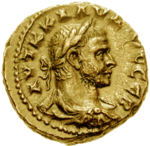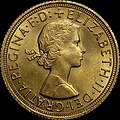Wikipedia:WikiProject Numismatics/newsletter/January 2020

|
The WikiProject Numismatics newsletter |
|---|---|
| Issue X | |
Announcement[edit]
It's a new decade, one that will no doubt be filled with historic numismatic events. New currencies will be created and old currencies will be phased out. Who knows, maybe a surviving 1964 Peace dollar will be discovered. Whatever it will be, we as a WikiProject will continue to contribute new numismatic knowledge to Wikipedia throughout the 2020s and beyond.
Article of the Month[edit]
The sovereign is a gold coin of the United Kingdom, with a nominal value of one pound sterling. Struck from 1817 until the present time, it was originally a circulating coin accepted in Britain and elsewhere in the world; it is now a bullion coin and is sometimes mounted in jewellery. In most recent years, it has borne the well-known design of Saint George and the Dragon on the reverse; the initials (B P) of the designer, Benedetto Pistrucci, are visible to the right of the date.
The coin was named after the English gold sovereign, last minted about 1603, and originated as part of the Great Recoinage of 1816. Many in Parliament believed a one-pound coin should be issued rather than the 21-shilling (1.05 pounds) guinea struck until that time. The Master of the Mint, William Wellesley Pole, had Pistrucci design the new coin, and his depiction was also used for other gold coins. Originally, the coin was unpopular as the public preferred the convenience of banknotes, but paper currency of value £1 was soon limited by law. With that competition gone, the sovereign not only became a popular circulating coin, but was used in international trade and in foreign lands, trusted as a coin containing a known quantity of gold.
The British government promoted the use of the sovereign as an aid to international trade, and the Royal Mint took steps to see that lightweight gold coins were withdrawn from circulation. From the 1850s until 1932, the sovereign was also struck at colonial mints, initially in Australia, and later in Canada, South Africa and India—they have been struck again in India since 2013 (in addition to the production in Britain by the Royal Mint) for the local market. The sovereigns issued in Australia initially carried a unique local design, but by 1887, all new sovereigns bore Pistrucci's George and Dragon design. Strikings there were so large that by 1900, about 40 per cent of the sovereigns in Britain had been minted in Australia.
With the start of the First World War in 1914, the sovereign vanished from circulation in Britain, replaced by paper money, and it did not return after the war, though issues at colonial mints continued until 1932. The coin was still used in the Middle East, and demand rose in the 1950s, which the Royal Mint eventually responded to by striking new sovereigns in 1957. It has been struck since then both as a bullion coin and, beginning in 1979, for collectors. Though the sovereign is no longer in circulation, it is still legal tender in the United Kingdom. (Full article...)
News[edit]
Project[edit]
- The 2019 US Banknote Contest has ended. It was the first contest to be run by WikiProject Numismatics. However, due to the fact that there were only 3 participants (only one of which actively participated) and some controversy over the method of invitation, it will likely be the last US Banknote Contest. Nonetheless, it provided Wikimedia Commons with 220 new currency images for use in the various Wikimedia wikis.
Content[edit]
Featured Articles
Miscellaneous[edit]
- Have a happy new year!
On the Main Page[edit]
Today's Featured Article[edit]
| December 22 |
|
The Maryland Tercentenary half dollar was a commemorative fifty-cent piece issued by the United States Bureau of the Mint in 1934. It depicts Cecil Calvert, 2nd Baron Baltimore, on the obverse (pictured) and the coat of arms of Maryland on the reverse. The Maryland Tercentenary Commission sought a coin in honor of the 300th anniversary of the arrival of English settlers in Maryland. The state's senators introduced legislation, and it passed both houses of Congress with no opposition. A design had already been prepared by Professor Hans Schuler; it passed review by the Commission of Fine Arts, though there was controversy over whether Lord Baltimore, a Cavalier and Catholic, would have worn a collar typical of Puritans. The Commission sold about 15,000 of the full issue of 25,000 for $1 each, and thereafter discounted the price for large sales to dealers and speculators. The coins have increased in value over time, and are now valued in the low hundreds of dollars. (Full article...) |
| December 27 |
|
Salih ibn Mirdas (died 1029) was the founder of the Mirdasid dynasty and emir of Aleppo from 1025 until his death. His sons and grandsons ruled Aleppo for most of the next five decades. In 1008 he seized the Euphrates river fortress of al-Rahba. He was imprisoned and tortured in 1012 by the emir of Aleppo, Mansur ibn Lu'lu', before escaping two years later and capturing Mansur in battle. With his Bedouin warriors, Salih captured a string of fortresses along the Euphrates, including Manbij and Raqqa, by 1022. He later allied with the Banu Kalb and Banu Tayy tribes in their rebellion against the Fatimids of Egypt, who ruled Aleppo. He annexed the central Syrian towns of Homs, Baalbek and Sidon before conquering Aleppo in 1025 and establishing a well-organized administration. He paid formal allegiance to the Fatimids, but his alliance with the Banu Tayy drew him into conflict with the Fatimid general, Anushtakin al-Dizbari, whose forces killed Salih in battle near the Sea of Galilee. (Full article...) |
Picture of the Day[edit]
| December 11 |  |
The Japanese government-issued Philippine peso was a form of fiat money issued in the Philippines by the Japanese government during World War II as part of its occupation of the archipelago. The first issue in 1942 had notes valued at 1, 5, 10 and 50 centavos, and 1, 5 and 10 pesos. A new series of peso denominations were issued in 1943, and hyperinflation resulted in a further issue in 1944, with the higher value notes of 100 and 500 pesos being added.
This picture shows the obverse (top) and reverse (bottom) sides of a 1000-peso note that was issued in 1945, shortly before the country was liberated by Allied troops. The banknote is in the National Numismatic Collection of the Smithsonian Institution's National Museum of American History. |
Did You Know...[edit]
- ... that ancient Gupta art of India includes gold coins commemorating the Ashvamedha Vedic horse sacrifice (example pictured)? (December 18)
New members are added to the subscriber list • If you are not a member and would like to receive this newsletter, or are a member but would not like to receive future issues, you may subscribe/unsubscribe here




